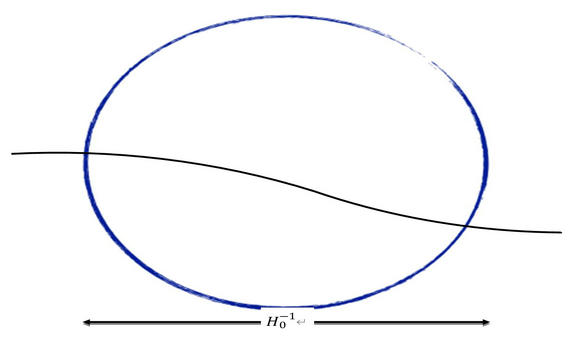Tiny but very large wavelengthperturbations solve Hubble Tension

Figure 1: The sketch depicts a perturbation of very large wavelength, larger than the size of the maximum distance light could have travelled since the origin of the Universe. The volume inside is the visible universe. (Credit: Prabhakar Tiwari)
It is generally believed that the Universe is isotropic and homogeneous on large distance scales, i.e., there is no preferred position or direction in the Universe. This hypothesis forms the basis of the standard Big Bang cosmology and is called the cosmological principle (CP). It implies that the Universe is expanding and, to a good approximation, has exactly the same properties at all spatial positions.
This is applicable only in a special frame of reference, called the cosmic frame of rest. Besides this smooth background, there also exist small fluctuations which lead to the formation of galaxies and other structures. Although these are not distributed homogeneously, they follow CP in a statistical sense. For example, the matter density in the Universe is expected to be the same at all positions after averaging over a sufficiently large distance scale. Its precise value is so far unknown but is generally believed to be larger than about 3000 billion kilometers.
CP does not follow from the laws of fundamental Physics and has to be conjectured as an independent hypothesis. Furthermore, it is consistent only if we assume inflation, i.e., a phase during which the Universe went through very rapid exponential expansion, soon after its origin. The researchers also believe that the very early Universe may not be isotropic and homogeneous. It acquires this property during initial phase of inflation.
The principle appears to be observationally valid to a good approximation. However, detailed observations reveal small but significant deviations from isotropy. The matter distribution is found to be higher in one direction compared to the others. Technically, it displays a dipole pattern. Although a part of this can be attributed to our motion with respect to the cosmic frame of rest, this does not seem to be the whole story.
Interestingly, there is another anomalous observation. The observed Hubble parameter, which is a measure of the rate at which the Universe is expanding, also indicates that the local Universe is special and not the same as the Universe elsewhere. Essentially, its value extracted from nearby galaxies seems to deviate from that measured globally. The latter would be the expected mean value over the entire Universe. This deviation is called the Hubble tension and at present is one of the most pressing problems in cosmology.
It has been suggested that the observed deviations from isotropy can be explained if we consider cosmic perturbations or fluctuations with wavelengths larger than the size of the horizon. Horizon is the maximum distance light could have traveled since the origin of the Universe. These are called superhorizon modes. It is assumed that for very large wavelengths, these modes are aligned along the same direction. Hence these do not obey CP.
A research team, led by Dr. Prabhakar Tiwari from the National Astronomical Observatories of Chinese Academy of Sciences (NAOC), has found that miraculously these modes also explain the observed Hubble tension. The findings of the research have recently been published on The Astrophysical Journal Letters (ApJL).
"The new finding connects the two most crucial issues of modern cosmology that have attracted the attention of a large number of cosmologists and astronomers today and a priori appear disconnected from one another. Furthermore, as the redshift is a crucial observable in cosmology, its corrections due to superhorizon modes would be of fundamental interest," said the lead author Prabhakar Tiwari who is a researcher at NAOC.
The research paper can be accessed at https://iopscience.iop.org/article/10.3847/2041-8213/ac447a